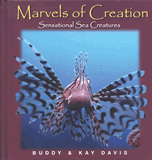Electric Ray
Electric rays are slow-moving and live partially buried in the sand or mud on the bottom of the sea. There are over 30 species of electric rays.
All electric rays generate charges of electricity with special organs on each side of the front of the body. These organs are honeycombed, fibrous-walled columns filled with a jelly-like matrix which are connected by nerves to the brain. Each unit or column serves as a battery with a negative on the lower side and a positive on the upper side. The two electric organs are capable of generating 200 volts, but, like all batteries, the electric ray can run down after repeated discharges. It has to rest before it can shock again.
The electric ray uses its shock to keep predators away and to capture fish that would ordinarily be too fast for the slow-moving ray. Electric rays usually feed on small crustaceans and other small prey.
The largest electric ray known, the Atlantic torpedo (Torpedo nobiliana), is found in the north Atlantic Ocean. It is up to six feet (1.8 m) long and weighs up to 300 pounds (136 kg). One of the smallest electric rays, Narcine brasiliensis, lives in the warmer waters off the shore of North Carolina and is one foot (30 cm) long. The average size of an electric ray is 30 pounds (13.6 kg).
Not a lot of information is known about the young except that they are born alive. One female had ten one-inch (2.5 cm) diameter eggs inside her.
Man does not fish for this creature and only encounters it by accident when it gets caught in a fishing net. It must be released very carefully to avoid being shocked.
Electric Ray
Batoide • Torpedinid
Weight: 30 pounds (13.6 kg)
Length: Up to 6 feet (1.8 m)
Special Design Feature: Electric rays have
two electric organs on the top of the head
that produce the electricity.
Did You Know? Some electric rays can
produce 200 volts of electricity.

Marvels of Creation: Sensational Sea Creatures
Brings the world of the sea alive in a unique and colorful way with photographs, a page of facts and commentaries.
Browse Kids BookRecommended Resources
- © 2025 Answers in Genesis
- Privacy Policy
- Contact
- About



